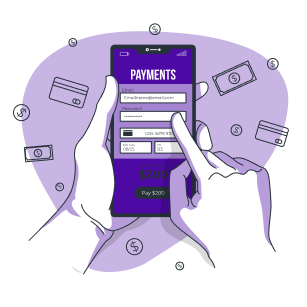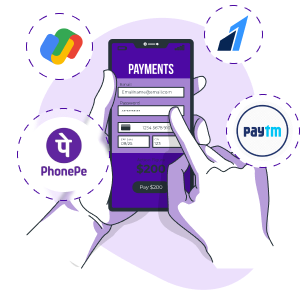
Payment Gateway Integration- Everything You Need To Know
Table of Contents








Whether you are an online business owner or an e-commerce platform, you would want your customers to have a hassle-free online payment system. To simplify online payments, you must integrate a payment system that meets the requirements of your business and your customers. For instance, it has to protect customers from fraud, support different payment methods, be easy to use and be compatible with your business and so on. An easy payment gateway integration can simplify the online payment system for your businesses and customers. So choosing the right payment gateway is very important. But before we jump right into choosing the payment gateway, let us first understand the payment gateway and how it works.
What is a Payment Gateway
A payment gateway is a service portal that facilitates secure transactions between businesses and customers.
It uses various kinds of encryption and security protocols to facilitate transactions between merchants and
customers.
Types of transaction of payment gateways :
How Payments Work through a Gateway

The online payment process involves various financial institutions, many tools, and verifying data on both ends to allow customers to finish the purchasing process. When the customer checks out, the payment gateway performs several functions to complete the transaction process. They are:
- Customer - When a customer places an order, the data gets encrypted and sent to the merchant’s server through an SSL connection.
- Payment gateway - When the merchant receives the data, it gets passed to the payment gateway via a different SSL connection.
- Payment processor - The information from the merchant comes to the payment processor, as the payment gateway does not store any data. Then they pass on the information to the card network.
- Card Network - The primary role of the card network is to verify the transaction information and pass it to the issuer bank.
- Issuer bank - If the issuer bank accepts the authorisation request, it sends a code( contains transaction status) to the payment processor.
- Payment gateway - When it receives the code from the issuer bank, it is then passed to the website.
- Issuing bank - Then the customer gets a message with payment status(denied or accepted).
- Acquirer bank - If the customer accepts the transaction, the funds get transferred from the issuer bank to the acquirer bank.
Now that you know how payment gateway works, let us now understand the integration methods of the payment gateway system into your website.
Types of Payment Gateway Integration
There are various types of payment gateway integration methods. Let us explore them one by one and see which is the best fit for your business.
Hosted gateway
A hosted gateway is a third-party payment gateway provider. It requires the customers to go to the payment gateway page to finish the transaction process. When the transaction is complete, the customer gets redirected to the merchant’s page.
1. Advantages of Hosted Gateway Payment System
- No PCI DSS compliance is required.
- Hosted Payment gateway takes care of all payment processes.
- Customer card data is stored by the dealer.
2. Disadvantages of Hosted Gateway Payment System
- Lack of control
- Customers may not trust a third-party system
- A complicated system may lead to a lower conversion rate
Integration
Hosted payment gateway is integrated through an API. It is best for businesses that want to use an external payment gateway provider.
Direct Post
Direct Post is another integration process that lets clients complete their payments without leaving the merchant’s website.
1. Advantages of the Direct Post
- No PC DSS compliance is required.
- Customisation options are available
- Customers can complete all transaction procedures on the same page
2. Disadvantages of Direct Post payment gateway
- It is not completely safe
Integration:
An API is required between the merchant’s shopping cart and the payment gateway to post the card information. It is best for all kinds of business.
Non-hosted integration
It implies that no third party is involved in the payment procedure. This means, the companies can store data on all transactions. Sometimes many companies can use a white-label gateway (per-built payment gateway) of non-hosted integration. This allows the merchant to customise and brand it as their own. Some examples of white label gateway are MasterCard, Pay Pipes, Hips, PayXpert and so on.
1. Advantages of Non-Hosted Gateway
- Full control over the transaction process.
- Customise it accordingly to your business needs.
2. Disadvantages of Non-Hosted Gateway
- PCI DSS compliance is a must.
- Cost of the payment infrastructure.
Integration:
APIs are used to integrate non-hosted payment gateway integration services to the merchant’s server. So a vendor is required to do the integration. It is the best to fit for businesses that heavily focus on user experience and image building.
Factors that should be considered at the time of choosing a payment gateway solution

Now that you know about payment gateway integration, let's dive into know about important factors to consider before choosing the right provider
1.Cost- Like any other service, the payment gateway also requires a fee for using tools and authorizing the transaction. Every payment gateway provider has its own condition and fee structure. Usually, there are four types of fee structures. They are:
- Setup fee
- Monthly fee
- Merchant account setup fee
- A fee for each processed transaction So always read the plans carefully to avoid any additional expenses.
2.Transaction limits- Every payment gateway service provider sets a minimum and maximum limit. So choose the gateway that is compatible with your product's prices.
3.Payment methods - Always make sure that your payment gateway service provider accepts all kinds of credit cards and other payment methods.
4.Mobile payments - Many customers prefer to use the mobile payment gateway to complete their purchases.For instance, Google Pay, PhonePe, Apple Pay and so on. So make sure your payment gateway provider has mobile payments service.
To avoid these cumbersome and hidden expenses, you can always choose to build your custom Integration application which serves your needs way better.
Custom Gateway Integration

There are a lot of payment gateway providers that offer smooth transaction experiences to customers. But if you like, you can build your own payment gateway solutions. So here are the ways how to build a custom payment gateway solution.
How to build a custom payment gateway
Building a custom gateway requires many steps:
- Registration- When you are creating a payment gateway, first you have to register to several card networks through your acquiring bank.
- Contract banks- Banks will act as payment processors for you to handle all the transaction procedures. Different banks have different fees for transfers or currency exchanges.
- API development- Create an API for your payment gateway and write documentation within PCI DSS compliance.
- Tokenisation- This is a security measure to store sensitive information as it reduces the chance of fraud. Tokens contain all transaction information and cardholder data.
- PCI DSS certification-Become PCI DSS is compliant by implementing all the necessary steps and integrating fraud protection mechanisms.
- Choose multiple payment methods- Integrate multiple payment methods(PayPal, mobile payments etc) with their APIs. Management tools development-Create an administration application to control all merchant operations.
- Management tools development- Create an administration application to control all merchant operations.
Similarly, if you like, you can go for open-source gateway solutions. It will lower the cost of development but it will give you limited customisation options.
Advantages of Custom Gateway Integration
There are many advantages of a custom Payment gateway solution:
- Low transaction fees - Creating your own gateway provider can lower the transaction fee.
- Customisation -The main advantage of building a custom payment gateway is that you can add and customise any feature you like.
- Payment gateway as a product - When you build custom payment gateway solutions, you can offer this to other businesses.
Final Takeaway
So when you are looking for a payment portal or planning to build one for your business, integrate a payment gateway that supports various multiple payment methods, manages fraud and improves customer experience. In this article, we have tried to cover all the aspects of payment gateway integration and hopefully, this will help you to simplify your digital transaction.Let's discuss your project